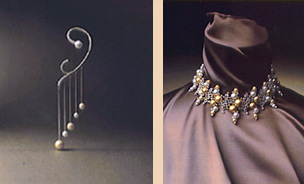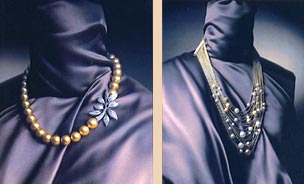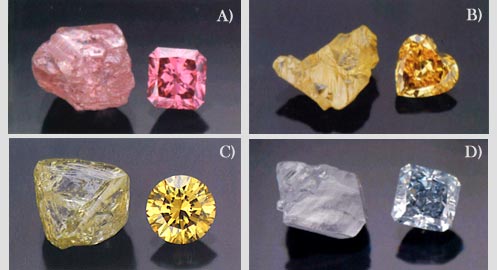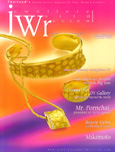| |
Mikimoto
Couleur Soleil |
|
| |
Mikimoto
has launched the "Couleur Soleil" Collection. Using the highest
quality pearls and diamonds this Collection concentrates on premium luxury
paying the greatest attention to the design and detail of each piece.
Designed and handmade in Japan these exclusive pieces will visit Dubai
early in 2007 and will be available at Damas Les Exclusives boutiques.
The radiant sun is the inspiration for this
new collection which highlights the rare Golden South
Sea pearl. The rich warm colour of the Golden Pearl is enhanced with White
South Sea and Akoya pearls, white and yellow diamonds set in platinum,
18K white or yellow gold. Designs include a choker necklace. Rays of 22
Golden and White South Sea pearls and 68 Akoya pearls are interspersed
with clusters of white and yellow diamonds totalling 30.74cts.
|
|
| |
A long snake chain necklace, layers
of 18K yellow gold chain with 10 South Sea pearls Golden and White
and 30 Akoya pearls randomly placed layer upon layer. The necklace
incorporates the patented mechanism Pearls in Motion which allows
the pearls to glide along the chain. Rows of diamonds are used as
two clasps which allow the necklace to be transformed into a bracelet.
A delicate ear-piece is a work of
art imitating the ears natural curves. Golden South Sea pearls and
Akoya pearls drop on 18K yellow gold snake chain. A White South
Sea pearl tops the ear piece while pave diamonds highlight each
curve.
|
|
 |
|
|
| |
"I
would like to adorn the necks of all the women of the world with pearls,"
Kokichi Mikimoto said after he succeeded in culturing a perfectly round
pearl. He seemed talking about an unachievable dream. However, the elegant
beauty of Kokichi's pearls was eventually recognized by women throughout
the world as Mikimoto became famous worldwide.
Kokichi devoted his life to the pearls that
he loved. After the mid 1800s, Japan became involved with foreign trade
and its natural pearls, became more treasured than ever before. At the
same time, the pearl oysters around Mikimoto's hometown of Ise-Shima were
being over-harvested to a crisis point. He threw himself into the task
of seeding oysters and creating pearls, and for decades, he spent every
waking hour on research and experiments. |
|
| |
 |
|
The
day he had been waiting for finally came on July 11, 1893. In
the company of his wife Ume, he raised one of the bamboo oyster
baskets out of the water, opened one of the oysters, and there,
inside the shell, he discovered a shining pearl. This was the
first time in history that a human being had ever created a pearl.
Once he had succeeded in culturing
a pearl, Kokichi's research grew. He had always been enchanted
by the glow of the black lipped pearls and silver lipped pearls,
and decided to try culturing them. In 1914, Ko-kichi opened a
culturing site for Black South Sea pearl oysters on Ishigaki Island
in Okinawa. In 1931 he turned his fantasy into reality with the
production of a giant pearl, 10mm in diameter. He also dispatched
a team of researchers to the South Pacific island of Palau, where
they had success in culturing pearls. |
|
|
| |
Kokichi
founded the world's first store specializing pearl jewelry in Tokyo's
Ginza district. In 1906, he moved the store to a new building in Ginza
4-chome. he Mikimoto Pearl Store offered Kokichi's keen sense tf contemporary
fashion in the form of beautiful, high-quality items. The Store, a product
of Kokichi's study of western aesthetics and his own unique sense of style,
soon attracted worldwide attention. |
|
| |
|
|
| |
What
gives a diamond color? |
|
| |
Look up
into a clear, cloudless blue sky and wonder, "What makes it blue?"
Look quickly there after a fresh summer rain and see the incredible rainbow.
What makes such a dazzling display of color? How do my eyes work and what
makes me see? Vision and color, such wonderful miracles in life both depend
on what many believe is the primary origin of all life - pure light.
It is the existence of light that brings
form from void, sight from non-sight, working in magic ways on molecules
of air-borne water that brings forth the rainbow. And it is pure light
reaching the internal essence of a color diamond that brings forth the
full spectrum of nature's palette to entice and envelop our sight. One
time blue, one time yellow, or brown, or olive or....the possibilities
are endless in hue, combination, intensity, saturation. But there is more
at work here than pure light and the world of natural color diamonds reveals
its complexities, subtleties and mystique. |
|
| |
 |
|
The
physical conditions necessary to color a diamond naturally occur
very scarcely, making natural color diamonds extremely rare. How
rare? For every natural color diamond, there are 10,000 colorless
ones that have made the trip to the Earth's surface. It is this
entirely natural process of geographical formation which ensures
that each natural color diamond is one of a kind.
The formation of natural color diamonds
is a process that requires the presence of not only the original
magical formula for all diamond creation, but also the oresence
of additional trace elements and distortions to the typical diamond
crystal. If an element interacts with carbon atoms during diamond
creation, the diamond's color can change. Radiation and pressure
on a diamond's structure will also impact its color as well. |
A) Fancy vivid pink - square octagon - radiant cut B)
Fancy yellowish orange - heart - heart brilliant cut
C) Fancy vivid yellow - round - brilliant cut
D) Fancy greyish blue - square octagon - starburst cut |
|
|
|
| |
What variables give diamonds their color?
Tremendous pressure exerted on a
diamond deep in the earth can abnormally compress its structure, thus creating
a red, pink,purple or brown stone. Evidence of graining, which scientists
believe is attributed to tremendous pressures under the earth can be seen
at 10x in many Argyle pink and cognac diamonds.
Natural radiation impacting already
formed diamonds over millions of years can give them a green hue.
www.ncdia.com |
|
| |
|
|



